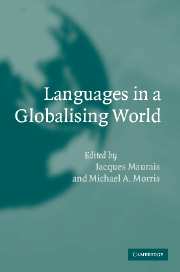1 - Introduction
Published online by Cambridge University Press: 18 November 2009
Summary
This book, Languages in a globalising world, addresses language changes in the global arena from several interrelated perspectives. Global communication challenges (Part I) are becoming increasingly prominent in a rapidly changing world characterised by rising interdependence. In Part I as well as elsewhere in this volume, theoretical and practical aspects of these challenges are assessed and interrelated. Rising language competition on a global scale varies from geographical region to region as does the spread of the English language (Part II), so that the ongoing impact of globalisation must be examined in general terms as well as from the perspective of the various geographical regions. To a considerable extent, the hierarchy and status of the major languages cut across geographical regions, so that attention must be addressed to them as well (Part III). The status of a number of major languages is analysed as well as how they impact on and are impacted by a rapidly changing international order. The status and resulting hierarchy of major languages encompasses a number of key issues affecting the new global linguistic order. Vitally important as well is how ongoing globalisation affects linguistic diversity or the fate of lesser languages.
This introduction poses several key considerations about each of the three parts of the book as well as the component chapters of each part. A summary follows about the contribution of each chapter towards the part in which it is located as well as towards furthering the overall purpose of the book.
- Type
- Chapter
- Information
- Languages in a Globalising World , pp. 1 - 10Publisher: Cambridge University PressPrint publication year: 2003
- 2
- Cited by

